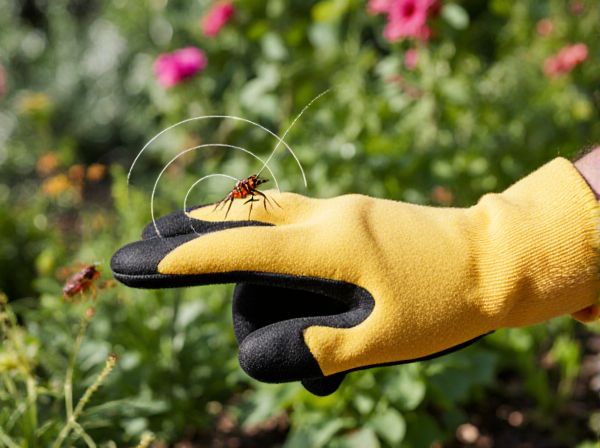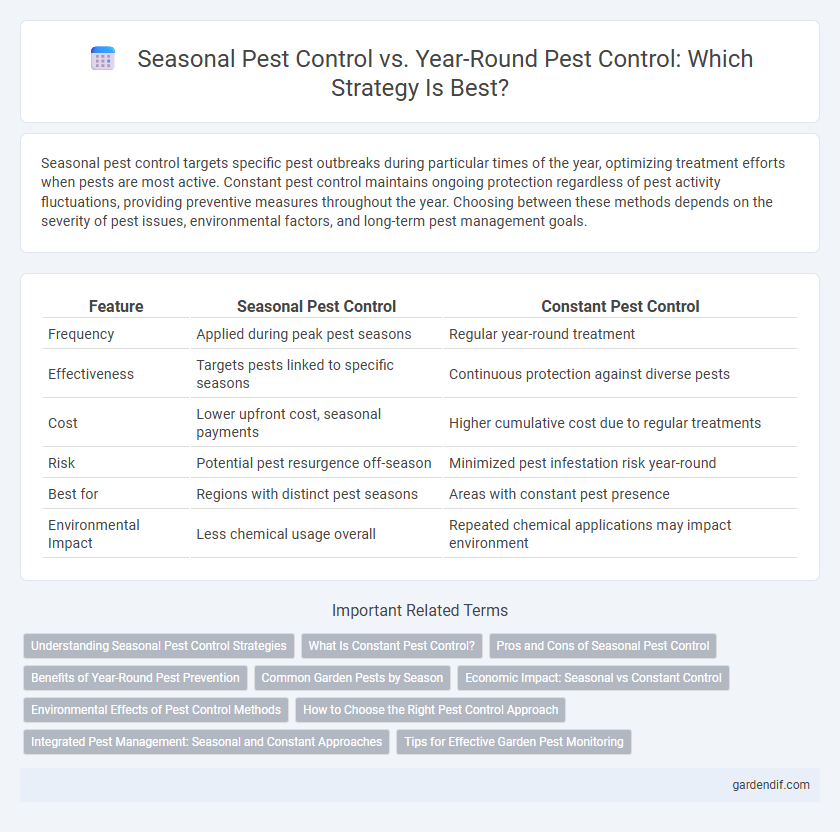
Seasonal pest control vs Constant pest control Illustration
Seasonal pest control targets specific pest outbreaks during particular times of the year, optimizing treatment efforts when pests are most active. Constant pest control maintains ongoing protection regardless of pest activity fluctuations, providing preventive measures throughout the year. Choosing between these methods depends on the severity of pest issues, environmental factors, and long-term pest management goals.
Table of Comparison
| Feature | Seasonal Pest Control | Constant Pest Control |
|---|---|---|
| Frequency | Applied during peak pest seasons | Regular year-round treatment |
| Effectiveness | Targets pests linked to specific seasons | Continuous protection against diverse pests |
| Cost | Lower upfront cost, seasonal payments | Higher cumulative cost due to regular treatments |
| Risk | Potential pest resurgence off-season | Minimized pest infestation risk year-round |
| Best for | Regions with distinct pest seasons | Areas with constant pest presence |
| Environmental Impact | Less chemical usage overall | Repeated chemical applications may impact environment |
Understanding Seasonal Pest Control Strategies
Seasonal pest control targets specific pests based on their life cycles and activity during particular times of the year, optimizing treatment effectiveness and reducing chemical use. Understanding seasonal pest patterns allows for timely intervention, preventing infestations before they escalate and minimizing environmental impact. Implementing seasonal strategies requires knowledge of local climate, pest behavior, and preventive measures tailored to peak activity periods.
What Is Constant Pest Control?
Constant pest control involves ongoing treatments scheduled throughout the year to maintain a pest-free environment regardless of seasonal changes in pest activity. This method targets a broad spectrum of pests consistently, preventing infestations before they occur by disrupting breeding cycles and eliminating early-stage pests. Unlike seasonal pest control, constant pest control ensures sustained protection, particularly in regions with year-round pest threats or indoor environments where conditions remain stable.
Pros and Cons of Seasonal Pest Control
Seasonal pest control offers targeted treatments during peak pest activity, reducing chemical use and lowering costs compared to year-round services. It is effective for pests with predictable life cycles but may leave gaps in protection during off-peak seasons, allowing infestations to reoccur. Limited coverage can result in more frequent outbreaks, requiring reactive measures that compromise long-term pest management efficacy.
Benefits of Year-Round Pest Prevention
Year-round pest control provides continuous protection against infestations, reducing the likelihood of pest damage and minimizing health risks throughout all seasons. Continuous monitoring and treatment adapt to changing pest behaviors and environmental conditions, ensuring effective prevention even during off-peak pest activity. This proactive approach improves long-term property maintenance and decreases the need for costly emergency pest treatments.
Common Garden Pests by Season
Seasonal pest control targets garden pests like aphids in spring, spider mites in summer, and slugs in fall, optimizing treatment timing for effective eradication. Constant pest control offers year-round protection against persistent pests such as ants and rodents that thrive across all seasons. Tailoring pest management to seasonal pest activity reduces chemical use and enhances garden health by addressing the specific needs of common garden pests throughout the year.
Economic Impact: Seasonal vs Constant Control
Seasonal pest control reduces expenses by targeting peak pest activity periods, minimizing unnecessary treatments and lowering operational costs. Constant pest control involves continuous monitoring and treatment, leading to higher labor and chemical expenses but providing comprehensive protection. Choosing between seasonal and constant pest control depends on balancing upfront costs with potential pest damage and long-term economic benefits.
Environmental Effects of Pest Control Methods
Seasonal pest control targets specific pest outbreaks during peak times, reducing overall pesticide use and minimizing environmental contamination. Constant pest control employs regular treatments that can lead to pesticide accumulation, increased resistance in pests, and adverse effects on non-target organisms including pollinators and soil microbiota. Implementing integrated pest management strategies in seasonal treatments enhances ecosystem health by promoting biodiversity and reducing chemical runoff into water sources.
How to Choose the Right Pest Control Approach
Choosing the right pest control approach depends on factors like local climate, pest activity patterns, and property vulnerability. Seasonal pest control targets specific times of pest infestations, leveraging predictable cycles to maximize effectiveness and reduce costs. Constant pest control provides continuous protection, ideal for year-round pest-prone environments or commercial properties requiring ongoing monitoring and treatment.
Integrated Pest Management: Seasonal and Constant Approaches
Integrated Pest Management (IPM) combines seasonal and constant pest control methods to optimize effectiveness and minimize environmental impact. Seasonal pest control targets specific pest lifecycles during peak activity periods, reducing chemical use and promoting ecological balance. Constant pest control maintains continuous monitoring and intervention, ensuring early detection and prevention of infestations to protect crops and structures year-round.
Tips for Effective Garden Pest Monitoring
Seasonal pest control targets specific pest outbreaks during peak periods, requiring timely identification of infestation patterns and environmental conditions. Constant pest control involves regular monitoring and intervention irrespective of seasons, emphasizing ongoing vigilance through consistent garden inspections and use of integrated pest management tools. Effective garden pest monitoring incorporates tracking pest life cycles, employing pheromone traps, and maintaining detailed records for adaptive treatment strategies.
Seasonal pest control vs Constant pest control Infographic

 gardendif.com
gardendif.com